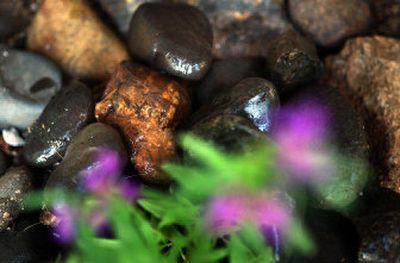Rocks make poor mulch

I was going to wait until fall but as you requested questions here you go: Rather than bark, we decided to use small grey rocks as cover for our extensive flowerbeds. Now, everything I read says to mulch to protect the plants from freezing. How do I do that with the rocks?
Irene Silverman, Spokane
Unfortunately, rocks do not insulate worth beans. On the other hand not all plants need to be protected from winter. If you have a few plants that need protection, simply lay down some burlap and then apply your usual insulating materials. The burlap allows water to get into the soil but keeps most of the mulch particles out of the rocks.
While we are on the subject of rock mulches: Rock may not be the best choice to cover your flowerbeds. While they last forever, rocks absorb heat from the sun which is then transferred to the soil overheating it and causing rapid loss of moisture right at a time when we need to be conserving soil moisture. Organic mulches like bark or compost are a better choice for this.
In the fall, organic mulches are easier to pull up around the plants to provide protection.
Lastly, rock mulches are hard to keep debris-free if they are close to plants that shed needles and leaves.
Wall cover-up suggestions
I enjoy your articles in Home and have a few questions. We live in the northwest part of Spokane and have a tall concrete wall in our backyard. I would like to plant something that will cover it up. The wall faces west, do you have any suggestions? Perhaps something that grows quickly? Also, when are we supposed to trim back the rhodies? In the fall? After they bloom? We are now just getting into this yard- and garden-mode as fairly new retirees, and have found we need some help.
Sue Baltzell, Spokane
You don’t mention how tall your wall is or whether it gets any shade at all, so I will assume somewhere around four- to six-feet tall and no shade. I also am assuming you can easily get water to the top or the bottom of the wall where you are going to plant.
For evergreens consider the flat horizontal junipers like Wiltoni, Bar Harbor or the Japanese garden juniper. If you like gold foliage, add a Golden Wiltoni or Mother Lode.
For vines think about Virginia creeper or a trumpet vine. Both are very vigorous and will need to be planted at the base of the wall with a heavy trellis. Ivy could be planted at the top to cascade down.
For perennials, think about candytuft, creeping phlox, creeping sedums or even hardy ice plant. Check out the wall on the east side of Manito Park’s Rose Garden for other inspirations.
Rhododendrons don’t need pruning unless they are completely out of bounds. Then it can only be done in the spring after they finish flowering.
Check out the American Rhododendron Society’s pruning tips at http://www.rhododendron.org/pruning.htm.